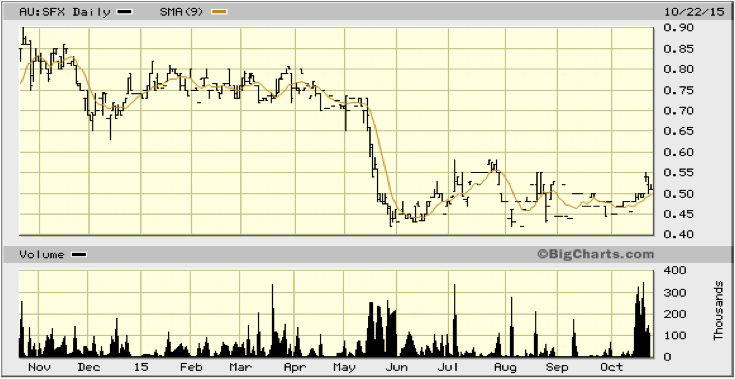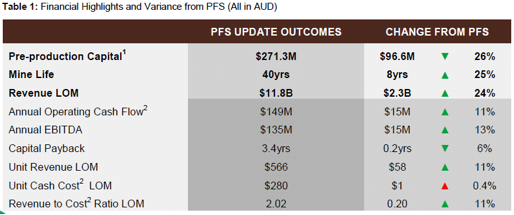An advanced explorer with a strong technical pedigree that’s pursuing aggressive exploration and appraisal activity with respect to its Tennant Creek acreage, in conjunction with quality partner Evolution Mining.
| Corporate Details |  |
| Status: Emerging Producer | |
| Size: Small Cap | |
| Commodity Exposure: Multi | |
| Share Price: $0.73 | |
| 12-month Range: $0.42 – $0.90 | |
| Shares: 134m, Options: 8m | |
| Top 20: 45% | |
| Net Cash: $4.6m | |
| Market Value: $107m |
| Key Parameters | Rating (✓out of 5) | Quarterly Statistics |
| Management Quality | ✓✓✓✓✓ | Q4 2014 Exploration Spend: $3.95m |
| Financial Security | ✓✓✓✓✓ | Q4 2014 Administration Spend: $0.227m |
| Project Quality | ✓✓✓✓✓ | Exploration Spend 95%, Admin. Spend 5% |
| Exploration / Resource Potential | ✓✓✓✓✓ | Q1 2015 Forecast Exploration Spend: $1.1m |
| Project Risk | ✓✓✓✓✓ | Q1 2015 Forecast Admin. Spend: $0.25m |
Sheffield Resources is an advanced bulk commodity play with a strong management pedigree. The company’s primary attraction is that it provides a rather unique proposition for investors, incorporating a diverse mix of advanced bulk commodity projects within Western Australia. The major driver of interest at present however is the company’s Dampier mineral sands project, within which the Thunderbird deposit has now been proven to host a world-class deposit in terms of both size and grade.
Bulk commodities typically present a challenge for junior companies, however Sheffield’s board and management team have demonstrated that they possess the requisite skills and experience to advance and extract full value from these types of assets. The company boasts the previously-successful, formerly ASX-listed Warwick Resources management team. Not many junior companies can manage one, let alone a host of bulk commodity opportunities; however Sheffield is successfully managing to do just that.
There is also solid interest and strong levels of appraisal activity with respect to the company’s other exploration assets, comprising its Red Bull exploration project near Sirius Resources’ high-profile Nova discovery in the southern Fraser Range, along with its Big Bullocks project in the Northern Fraser Range. These projects are important in terms of providing a high level of exploration sizzle, whilst the company simultaneously appraises and advances its Thunderbird mineral sands project towards production status.
Recent Activity
Thunderbird Test-Work Results
Sheffield has announced positive results from metallurgical test-work conducted on ilmenite from its 100%-owned Thunderbird mineral sands project, located near Derby in Western Australia.
The test-work focused on reducing the Fe2O3 levels and increasing the TiO2 content of the ilmenite in order to obtain a product that will command a higher selling price and be sold into a broader market.
This has been achieved via a simple, low-temperature (4500C) reduction roast, and subsequent magnetic separation stage, which has upgraded TiO2 in the primary ilmenite by 22% to 56.1% TiO2, whilst also increasing the FeO to Fe2O3 ratio.
The LTR process has proven extremely efficient at reducing Fe2O3 within the ilmenite, resulting in a significant increase in both TiO2 grade and acid solubility.

%TiO2 solubility vs grade, Sheffield LTR ilmenite product (red) benchmarked against known sulphate ilmenites (blue)
Technical Significance
The TiO2 solubility of the Thunderbird LTR ilmenite was benchmarked against several known commercial ilmenites that are suitable for existing sulphate plants. The LTR ilmenite is in the highest bracket of solubility, and has a higher TiO2 grade than all the ilmenites tested in the benchmarking exercise.
The results of the sulphuric acid solubility test-work show that the TiO2 solubility for the 4500C LTR ilmenite product is very high at 96.2%, using an acid-to-ore ratio of 1.67. The results also confirm that the primary ilmenite can be substantially upgraded using a simple LTR process.
The LTR process and magnetic separation acts as a homogenising process, reducing variability in the ilmenite product. This is important in a competitive market environment, where it is essential to be able to deliver a consistently high-quality product.
The results confirm that the LTR ilmenite from Thunderbird will be one of the highest-grade sulphate ilmenites globally and should be a preferred feedstock that is likely to displace poorer-quality ilmenites.
Updated Pre-Feasibility Study
The Thunderbird deposit is located on the Dampier Peninsula about 60km west of Derby. The May 2015 Pre-feasibility Study (PFS) confirmed Thunderbird as a long-life, zircon-rich project that has the potential to deliver strong margins over an initial 32-year mine life.
The company has just announced an updated PFS that contains significant improvements to the previous PFS study, which have enhanced the project’s overall economics and technical feasibility.

Pre-production capital costs have decreased by $96.6M – or 26% – to $271.3M. The decrease is largely attributed to a reduction in initial mine throughput from 18Mtpa to 12Mtpa with a resultant decrease in capital expenditure associated with mining and processing.
The pre-production capital total includes $27.7M for an ilmenite upgrade, plant which will allow Sheffield to produce large quantities of consistently high-quality, high-grade sulphate ilmenite over the 40-year mine life.
The operation will be ramped up to a throughput of 18Mtpa in year eight, well past the initial capital payback period of 3.4 years. The ramp-up involves straightforward modular additions of plant and equipment which will be fully-funded by operating cash flow.
The shortened capital payback is due to lower pre-production capital and scheduling of high-grade, near-surface mineralisation during early production years (the initial six-year pit has an average grade of 15.7% heavy mineral). In addition, further cost savings have been made to on-site and off-site infrastructure, including a Build Own Operate (BOO) arrangement for the accommodation camp and power station.
The mine life has increased substantially – by 25% – to 40 years, confirming the project’s capacity to supply globally significant quantities of high-quality products to the market over a long period of time.
The processing flow sheet now includes an ilmenite upgrade step using a low temperature roast (“LTR”) to upgrade the primary ilmenite by 22% to produce a high grade (56.1%) sulphate ilmenite. This will be one of the highest grade sulphate ilmenites in the global market. Smelter modelling test work also confirms the LTR ilmenite is suitable feed for producing high quality TiO2 slag (89.8% TiO2) and pig iron. Higher forecast pricing for the LTR ilmenite product is the principal driver of the 11% increase in unit revenue.
The PFS outlined average annual production comprising 114,000 tonnes zircon, 439,000 tonnes ilmenite and 30,000 tonnes of HiTi84 leucoxene – representing approximately 8% of global zircon and 4% of global TiO2 feedstock markets.
Project Overview
The Dampier project comprises a vast regional acreage position, situated 60km west of Derby in Western Australia’s Kimberley region. Thunderbird is the first major mineral sands deposit to be discovered in the Canning Basin, which is rapidly emerging as an important new mineral sands province. The project was explored by previous owner Rio Tinto from 2004 until 2009. Rio’s decision at the time to relinquish the project had very little to do with overall prospectivity – rather, in the wake of the GFC, Rio had to clear the decks and reduce expenditures.
Summary
The PFS update has confirmed that the Thunderbird project is a strategic, high-margin, zircon-rich asset, located in one of the world’s most stable mining jurisdictions. It is a project that requires modest capital expenditure, yet generates strong EBITDA margins over a very long mine life. Thunderbird represents probably the world’s best emerging mineral sands deposits and Sheffield has a proven board with skills in commercializing these types of projects. Accordingly Sheffield Resources will remain held within our Portfolio.







